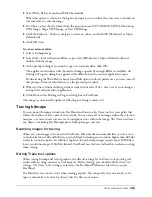
Chapter 10
314
Importing DXF files
DXF is a vector graphic file exchange format used to transfer files between 3D editing
applications, or between 3D editing applications and vector drawing applications. Most 3D
editing applications, including AutoCAD and 3DS Max, support DXF format.
FreeHand can import DXF images saved in ASCII or binary format. FreeHand ignores DXF file
information that it cannot render, such as 3D splines or other 3D-specific features.
When preparing a 3D file from another application for DXF import into FreeHand, follow these
guidelines:
•
Flatten the document. Remove any 3D splines or other 3D-specific features of the drawing;
FreeHand ignores 3D-specific features when it opens the file.
•
To retain consistent text formatting and placement, use common TrueType fonts in files to
be imported into FreeHand. FreeHand converts multiline text to the default font when it
imports a file.
•
For best control over positioning and placement of the imported graphic, prepare the 3D
file from the default document view. FreeHand renders imported DXF files in a single,
two-dimensional view.
To set DXF import preferences:
1
Do one of the following:
•
In Windows, select File > Import. In the Import Document dialog box, select AutoCAD.DXF
(*.dxf ) from the Files of Type pop-up menu. Navigate and select the filename. Click Setup.
•
On the Macintosh, press U and click the Import category.
2
Select one of the DXF filter preferences:
Import Invisible Block Attributes
imports DXF objects with invisible stroke and fill attributes.
Convert White Strokes to Black Strokes
converts stroke color from white to black.
Convert White Fills to Black Fills
converts fill color from white to black.
3
Click OK.
Importing EPS and DCS EPS files
EPS (Encapsulated PostScript) files can contain vector graphics, bitmap images, or both. If
clipping paths are present, the clipping path information is preserved. EPS is the best file format
for preserving prepress-ready color.
By default, FreeHand imports an EPS graphic as a linked file, not an embedded file.
You can import DCS (Desktop Color Separation) EPS 1.0 or 2.0 files as linked files to increase
the speed of printing high-resolution EPS files. A DCS 1.0 file actually consists of five separate
files—a low-resolution, composite preview and a separate file for each process (CMYK) color—
whereas a DCS 2.0 file contains the same data in a single file. When FreeHand creates process-
color separations, it gathers information from the other four component files and outputs them to
the appropriate plates.
When you import a DCS 2.0 EPS file, FreeHand automatically uses the low-resolution data for
display and the high-resolution data for output to the appropriate plates.
Note:
Import a DCS EPS file as a linked image; do not embed it. For more information on linking and embedding,
see “Linking and embedding” on page 62.
Summary of Contents for FreeHand MX
Page 1: ...Using FreeHand MX Macromedia FreeHand MX...
Page 42: ...Chapter 1 42...
Page 192: ...Chapter 6 192...
Page 232: ...Chapter 7 232...
Page 288: ...Chapter 8 288...
Page 308: ...Chapter 9 308...
Page 340: ...Chapter 11 340...
Page 362: ...Chapter 12 362...
Page 374: ...Chapter 13 374...
Page 388: ...Chapter 14 388...






























